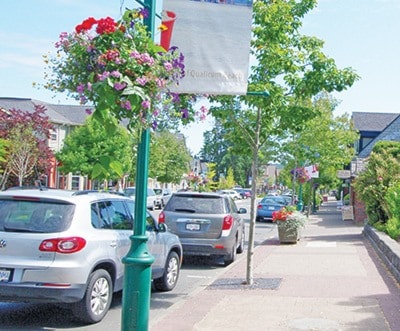A portion of Quaicum Beach’s controversial downtown development plan — called the Village Neighbourhood Planning Project — is set to go to a public hearing on Sept. 10, but some significant portions of the town’s new policy are already in place.
One item that represents a significant impact on a developer’s bottom line, is the town’s policy on offsite and works adjacent to a project. Set up per metre of street frontage, developers could pay as much as $5,000 for such things as undergrounding Hydro, cable, phone or power lines, curb and gutter, sidewalks and other services, impacted by their projects.
That amount descends to $3,000 and then to $1,000, depending on whether those works and services are high, medium or low requirements by the town.
Those amounts shocked a few members of council. Councillor Dave Willie asked how those numbers came up.
Town planner Luke Sales said those costs — such as the $5,000 per metre maximum — already existed in town policy and represent actual cost to the town if they did the work.
“The $5,000 is worst-case scenario,” he added.
Town engineer Bob Weir added in most cases of undergrounding wire, the cost to a developer would be $1,000 to $2,000 per metre.
Weir added the new policy puts a cap on the dollar amounts, noting the old policy had no cap on upper limits of laneway improvements.
Coun. Bill Luchtmeijer said he wanted the amounts to be cut in half.
“At minimum,” he continued, “as they are based on the most expensive, pie-in-the-sky developments ever proposed in town.”
Coun. Mary Brouilette asked what has been the average cost to developers for this kind of work in the past. Weir said it varries, but what this policy does, is set a limit.
“The costs could be less,” he said, “depending on the scope of work required.”
Still, Brouilette demanded that town staff justify their numbers.
“The dollars are a cap,” said chief administrative officer Mark Brown. “The cost (of a development), to financiers, is based on a developer’s own engineers plans and estimates.”
He repeated that the $5,000 figure is only a maximum, whereas a project’s offsite servicing costs could be much less.
Willie and Luchtmeijer took some time in getting past those figures, however, asking that staff consider cutting them by half — or more.
Coun. Scott Tanner said he liked the plan and wasn’t prepared to debate “the nuances” of the policy.
“We’re only looking at the town’s side,” he said. “If the property owners paid too much money for (their development property), that’s their problem.”
Mayor Teunis Westbroek sought to defer the vote on changing the policy to Sept. 10, in order to learn which properties would be most impacted by it, however, that failed to win support.
The policy eventually passed, unanimously.
The issue of allowing ground floor residential units in the downtown core also came up Aug. 13, and was sent on to the public hearing Sept. 10. The town’s new policy here would permit use of ground floor space as residential units, as long as the area could eventually be revamped as commercial. The site would be run almost like a strata to ensure single ownership and a return to commercial space, if required. Brown told council the town runs a similar piece of property already — town hall, which is home to both the library and the municipal offices.
Also on the Sept. 10 agenda is the matter of downtown building height. As proposed, council would consider buildings three storeys or more, as long as they meet the town’s existing village design guidelines.
Development cost charges round out the downtown planning debates. This, like the issue of building heights, was passed Aug. 13 in a 3-2 council majority (Westbroek and Tanner opposed this, as well as the new building height policy).
In a nutshell, the town council is about to pass a new DCC policy, reducing the cost to developers by as little as 30 per cent, to as much as 100 per cent. The new policy bases the reductions on “low environmental impact.”
That is based on existing services, infrastructure and the reduced use of vehicles in the downtown core.
Tanner said he spoke with a planner in Nanaimo — where a similar policy exists — and was told it had no effect on attracting new development to the city.
“It hadn’t done a damn thing,” he said.
While not a part of the public hearing, this policy is expected to pass in a vote on Sept. 10.
